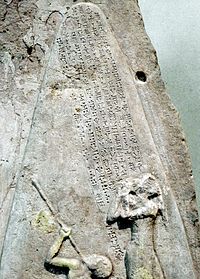Šutruk-Naḫḫunte II.

|

|
|
|
Narām-Sîn stele ; Detail: inscription of Šutruk-Naḫḫunte
|
||
Šutruk-Naḫḫunte II. (Also Schutruk-Nahhunte, Sutruk-Nahhunte ) ruled from about 1185 to 1155 BC. As king of Elam . He was the second ruler of the Šutrukid dynasty . Because of his conquest of Babylon , Šutruk-Nahhunte is considered the most important Elamite ruler. Archaeological finds with his name inscription from the city of Susa are among the most important archaeological monuments of the ancient Orient and prove his empire to be a cultural and political center in Mesopotamia of his time.
Life and domination
Šutruk-Naḫḫunte was the son of Hallutuš-Inšušinak , who is only known by his son being named in more than 450 inscribed bricks and who was probably the founder of the dynasty. Šutruk-Naḫḫunte is known from inscriptions in Elamite script on building bricks that prove his building activity. He had the Inšušinak temple in Susa expanded with a pillared hall and a gate made of glazed bricks. Four bricks mention that the ruler had the temple of Kiririsha-von-Lijan extended or at least renovated. Further construction work is attested in Deh-e Now , where he had the temple of Manzat expanded.
The Šutruk-Naḫḫuntes campaigns are documented in inscriptions on stone loot that he had brought to Susa, and which Jacques de Morgan found during archaeological excavations on the city's acropolis in 1902–1905 . In these he reports on the conquest of various Mesopotamian cities, including Babylon , Sippar and Akkad . At one point there is even talk of 700 cities that he conquered and claims to have forced high tribute payments. The most famous campaign led to Babylon, from where the ruler brought back rich booty. A second campaign to Babylon led to the conquest of the city. His son and successor Kutir-Nahhunte III. was installed there as governor. This was followed by Šilḫak-Inšušinak I. Another son Šutruk-Naḫḫuntes.
Šutruk-Naḫḫunte was married to a daughter of the Kassite king Meli-Šipak , whose name has not been passed down.
Mesopotamian loot in Susa
Between 1902 and 1905, numerous sculptures made of diorite , limestone and sandstone were unearthed during archaeological excavations in Susa . These included the famous legal stele of Hammurapi from Babylon, the victory stele of Naram-Sin from Sippar, and the victory stele of King Maništušu from Akkad, which are now kept in the Louvre in Paris . Šutruk-Naḫḫunte placed his name and a short inscription on many of the booty pieces. These inscriptions are all constructed according to the same scheme:
This is often followed by another reference to Inšušinak, under whose protection certain acts were carried out, such as I destroyed Sippar or I destroyed Ešnunna . Finally, what was taken as booty is mentioned.
Some of the objects several hundred years old at the time they were brought to Susa (such as the “Codex Hammurapi” or the Narām-Sîn-Stele) were placed undamaged at their new location and only received new inscriptions. Akkadian victory marks and Babylonian boundary stones ( Kudurru ) , on the other hand, were often found in a badly damaged condition. Unfortunately, the inadequate excavation technique using deep search trenches by today's standards and the inadequate documentation of the finds do not allow any statement to be made about the original arrangement and arrangement of the loot. According to Harper (1992), a kind of “exhibition” of the looted pieces is conceivable in Elam, perhaps in honor of the god Inšušinak mentioned in the inscriptions. The Elamite inscription on the Narām-Sîn stele expressly mentions that Šutruk-Naḫḫunte "protected it and brought it [...] to Elam", ie did not intentionally destroy it. The original Akkadian inscriptions on individual monuments are intact. The Elamite inscriptions often lack a name, even if the older Akkadian inscription is illegible. Some pieces could only be found at the time of the conquest and devastation of Elam by the Assyrian king Aššur-bāni-apli (Assurbanipal) in 646 BC. Have been destroyed.
Trivia
The person Šutruk-Naḫḫunte is used in the film Club of the Caesars (orig .: The Emperor's Club ) as one of the key elements. In the history teacher's classroom there is a plaque that reads “I am Šutruk-Naḫḫunte, King of Anšan and Susa, ruler of the land of Elam. I destroyed Sippar, took the stele from Naram-Sin and brought it to Elam, where I set it up in honor of my God. Šutruk-Naḫḫunte - 1158 BC. "
literature
- Daniel T. Potts : The Archeology of Elam , Cambridge University Press, Cambridge 1999, 232-237
Individual evidence
- ^ Translation of the inscription on the Louvre website , accessed October 16, 2017.
- ↑ Scheil: Textes élamites sémitiques, deuxième série . In: Jacques de Morgan (ed.): Mémoires de la délégation en Perse . Ernest Leroux, Paris 1905 ( bnf.fr [accessed October 16, 2017]).
- ↑ a b Prudence O. Harper, Pierre Amiet: Mesopotamian monuments found at Susa . In: Prudence O. Harper, Joan Aruz, Françoise Tallon (eds.): Royal city of Susa . The Metropolitan Museum of Art, New York 1992, ISBN 978-0-87099-652-8 , pp. 159-182 . Accessed PDF , accessed on October 16, 2017.
| predecessor | Office | successor |
|---|---|---|
| Hallutuš-Inšušinak |
King of Elam Shutrukids |
Kutir-Nahhunte III. |
| personal data | |
|---|---|
| SURNAME | Šutruk-Naḫḫunte II. |
| ALTERNATIVE NAMES | Šutruk-Šutruk-Naḫḫunte II. (Full name); Schutruk-Nahhunte, Sutruk-Nahhunte |
| BRIEF DESCRIPTION | King of Elam |
| DATE OF BIRTH | 13th century BC Chr. |
| DATE OF DEATH | 1155 BC Chr. |
